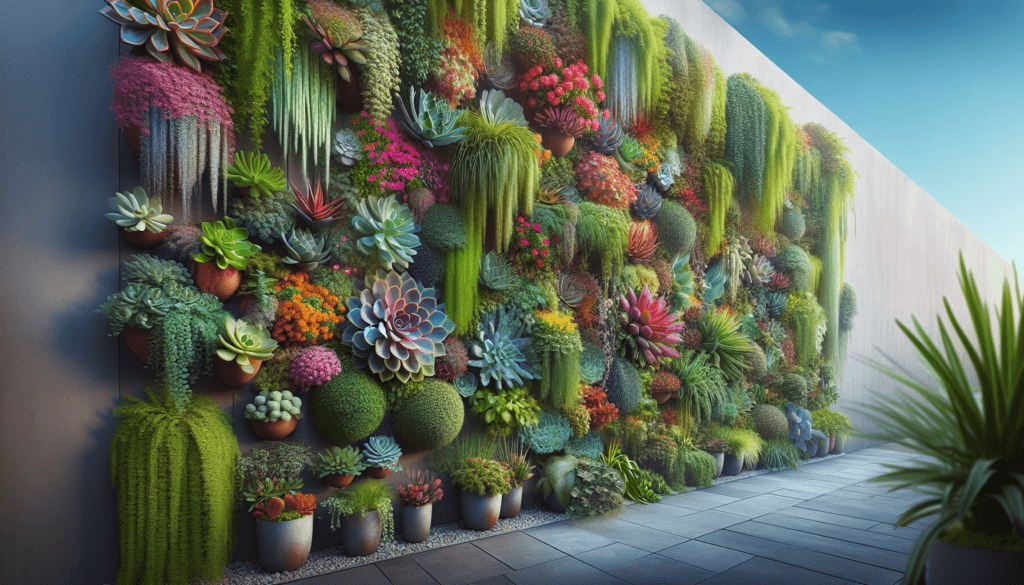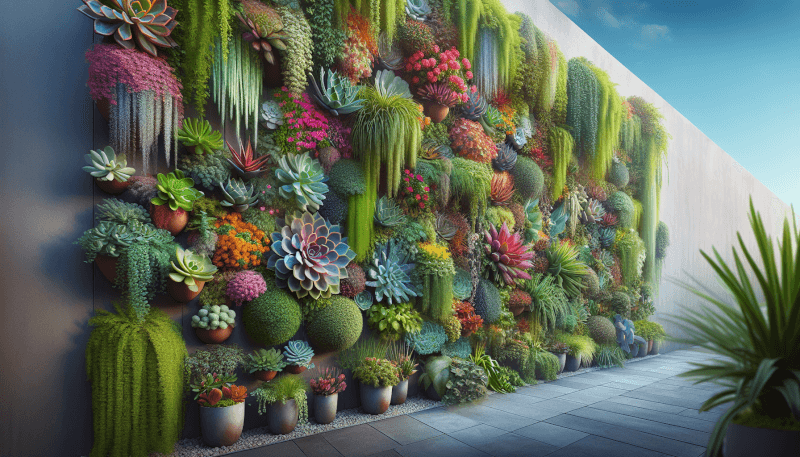If you’re looking to add some greenery to your space but don’t have much room to spare, a vertical garden could be the perfect solution for you. Creating a vertical garden allows you to grow plants upwards, maximizing your space and adding a touch of natural beauty. In this article, we will explore some of the best ways to create a vertical garden, from using trellises and pallets to utilizing hanging planters and pocket gardens. Get ready to transform your space into a lush oasis with these creative and practical ideas.

Benefits of a Vertical Garden
A vertical garden is not only a beautiful addition to any space, but it also offers a range of benefits that can greatly enhance your environment. One of the most notable advantages of a vertical garden is its ability to improve air quality. By adding plants to your vertical garden, you are increasing the oxygen levels in your surroundings, creating a healthier and more refreshing atmosphere.
Another significant benefit of a vertical garden is its space-saving nature. Whether you have a small balcony or a tight backyard, a vertical garden allows you to maximize your available space by utilizing vertical walls or structures. This is particularly beneficial for urban dwellers who may have limited gardening space.
In addition to its space-saving qualities, a vertical garden also adds visual interest to any setting. Whether you choose to create a vibrant flower display or a lush wall of greenery, a vertical garden serves as a focal point and creates a unique and eye-catching feature. The vertical arrangement of the plants adds an architectural element to your space, transforming it into a work of art.
Lastly, a vertical garden can help reduce noise pollution. The dense foliage of plants acts as a natural sound barrier, absorbing and dampening noises from the surrounding area. This is particularly advantageous if you live in a noisy neighborhood or near a busy road, as it can provide a peaceful and tranquil environment.
Choosing the Right Location
Before setting up your vertical garden, it is important to carefully consider the location where it will be placed. One of the key factors to take into account is sunlight exposure. Most plants require a certain amount of sunlight to thrive, so it is important to choose a location that receives adequate sunlight throughout the day. Keep in mind that different plants have varying sunlight requirements, so it is essential to choose plants that are suitable for the amount of sunlight available in your chosen location.
Another consideration when choosing the right location for your vertical garden is analyzing the wall structure. The wall or structure should be capable of supporting the weight of the plants and the support structure. Ensure that the walls are sturdy and capable of withstanding the weight and potential moisture of the vertical garden.
Proximity to a water source is also an important factor to consider. The plants in your vertical garden will require regular watering, so it is convenient to have a water source nearby. This will make watering your plants easier and more efficient.
If you have a terrace, it is an ideal location for a vertical garden. Terraces offer ample sunlight exposure and usually have strong walls or railings that can be used as support structures. Additionally, the proximity to a water source on a terrace makes it easier to maintain your vertical garden.
Materials Required for a Vertical Garden
To set up a vertical garden, you will need a few essential materials. Garden containers are essential for planting your chosen plants. These containers should be suitable for vertical gardening and should have adequate drainage holes to prevent waterlogging.
A support structure is also necessary to hold the garden containers in place. This can be a trellis, wire mesh, or a specialized modular system designed for vertical gardening.
Potting soil and compost are crucial for providing the necessary nutrients for your plants to thrive. Ensure you choose a high-quality potting mix that is suitable for the types of plants you intend to grow.
Selecting the right plants and seeds is also a key component of setting up a vertical garden. Consider the requirements of each plant, such as sunlight exposure and water needs, to ensure they are suitable for your chosen location.
A watering system is essential for maintaining the health of your vertical garden. This can be a drip irrigation system, a misting system, or even a manual watering method. Choose a system that suits your needs and the requirements of your plants.
Lastly, fertilizers may be necessary to supplement the nutrients in the soil. Choose organic or slow-release fertilizers that are suitable for your selected plants.
Building a DIY Vertical Garden
Creating a DIY vertical garden allows you to customize the design and adapt it to your preferences. When selecting a design, consider the available space and the aesthetic you want to achieve. There are various design options to choose from, including vertical pallet gardens, vertical hanging gardens, or modular systems.
Once you have chosen a design, start constructing the support structure. This may involve attaching a trellis or wire mesh to the wall or creating a freestanding structure. Ensure that the structure is stable and secure before proceeding.
Next, install the garden containers onto the support structure. Arrange them in a way that allows easy access and ensures optimum sunlight exposure for each plant.
Fill the containers with potting soil, leaving enough space for the roots of the plants to grow. Mix in compost to provide additional nutrients for the plants.
Now it’s time to plant your chosen plants. Follow the recommended planting depths and spacing for each plant to ensure they have enough room to grow.
Water your newly planted vertical garden thoroughly and regularly. Monitor the moisture levels of the soil and adjust your watering schedule accordingly.
Finally, maintain your vertical garden by pruning any overgrown plants and regularly removing weeds. Fertilize the soil as necessary to replenish nutrients. Regular care and maintenance will ensure the health and longevity of your vertical garden.

Vertical Garden Kits
If you prefer a more convenient and hassle-free approach to creating a vertical garden, vertical garden kits are an excellent option. These kits provide all the necessary materials and instructions to set up your own vertical garden with ease.
Using a kit offers several benefits. Firstly, it saves you time and effort by providing pre-designed support structures and containers. Secondly, kits often include specialized watering systems that ensure proper hydration for your plants. Finally, vertical garden kits are designed to be user-friendly and do not require extensive gardening knowledge or skills.
There are different types of kits available, including modular wall systems, hanging pocket systems, and freestanding tower systems. Consider the space you have available and the design you desire when choosing a kit.
When installing a kit-based vertical garden, carefully follow the instructions provided. Ensure the support structure is securely attached and the containers are properly positioned. Fill the containers with potting soil and compost, and plant your chosen plants according to the instructions.
Maintain your kit-based vertical garden by following the recommended watering and maintenance guidelines. Regularly monitor the health of your plants and make any necessary adjustments to ensure their well-being.
Vertical Garden Plant Selection
Choosing the right plants is essential for the success of your vertical garden. Consider the specific needs of each plant, including sunlight requirements, water needs, and soil preferences.
When selecting plants for an indoor vertical garden, choose species that can thrive in lower light conditions. Examples include pothos, snake plant, and philodendron. These plants can adapt well to the limited sunlight typically found indoors.
For outdoor vertical gardens, select plants that are suitable for the local climate and can withstand the environmental conditions. Consider the amount of sunlight available in the chosen location and choose plants accordingly. For sunny areas, plants such as petunias, marigolds, and geraniums are excellent choices. In shady areas, ferns, hostas, and begonias thrive.
Another factor to consider when selecting plants is their suitability for the vertical growing environment. Some plants are better suited for vertical growth due to their natural growth habits, such as vining plants or those with cascading foliage. Mixing different types of plants in your vertical garden can create a visually appealing display while also maximizing the functional and aesthetic qualities of the space.

Watering and Maintenance
Establishing a watering schedule is crucial for the health of your vertical garden. Different plants have varying water needs, so it is important to monitor the moisture levels of the soil and adjust your watering accordingly. Avoid overwatering, as it can lead to root rot and other issues.
To monitor moisture levels, check the soil regularly by inserting your finger into the soil. If it feels dry, it is time to water your plants. Use a watering can or a suitable watering system to ensure the water reaches all the plants evenly.
Choosing the right watering system can make maintaining your vertical garden easier. Consider using a drip irrigation system or a misting system, as they provide a consistent water supply to each plant. These systems can be automated to ensure your plants receive water even when you are not available to manually water them.
Regular pruning and fertilizing are essential for maintaining the health and appearance of your vertical garden. Prune any dead or overgrown foliage to encourage healthy growth. Trim vining plants to maintain their shape and prevent them from overpowering other plants.
Fertilize your vertical garden periodically to replenish nutrients in the soil. Choose a fertilizer that is suitable for your chosen plants and follow the recommended application rates.
Pest and disease control is another aspect of vertical garden maintenance. Regularly check your plants for signs of pests or diseases and take appropriate measures to address the issues. This may involve using organic pest control methods or seeking professional advice for more severe infestations.
Lighting for Indoor Vertical Gardens
When creating an indoor vertical garden, understanding the lighting needs of plants is crucial. Most plants require a certain amount of light to photosynthesize and thrive. While natural sunlight is optimal, artificial lighting can be used to supplement or replace sunlight in indoor environments.
When choosing artificial lighting for your indoor vertical garden, consider the specific light requirements of your plants. Plants typically require two types of light: blue light for vegetative growth and red light for flowering and fruiting. LED grow lights are a popular choice as they provide the necessary light spectrum and are energy-efficient.
Placement of lights is important for ensuring optimal growth. Position the lights directly above the plants or at an appropriate distance based on the specific lighting needs of each plant. Adjust the height of the lights as the plants grow to maintain proper light exposure.
To automate the lighting in your indoor vertical garden, consider using a lighting timer or a smart lighting control system. This allows you to set a consistent lighting schedule, ensuring your plants receive the right amount of light each day.

Vertical Garden Maintenance Tips
Regularly monitoring the health of your plants is essential for the long-term success of your vertical garden. Check for any signs of yellowing leaves, wilting, or pest infestation. Address any issues promptly to prevent further damage.
Pruning and trimming techniques are important for maintaining the shape and structure of your vertical garden. Remove any dead or dying foliage to encourage new growth. Trim vining plants to prevent them from overtaking other plants or the support structure.
Regularly check for pests and diseases that may affect your plants. Look for signs such as holes in leaves, webbing, or discoloration. Use natural pest control methods whenever possible, but seek professional help if the infestation is severe.
Maintaining the watering system is crucial for the health of your plants. Regularly check for any clogs or leaks and make necessary repairs. Ensure the water supply is consistent and that all plants receive adequate hydration.
Replenishing nutrients in the soil is necessary for the long-term health of your vertical garden. Use organic fertilizers to avoid chemical buildup and follow the recommended application rates. Regularly check the nutrient levels of the soil and adjust the fertilization schedule as needed.
Creative Enhancements for Vertical Gardens
To add a touch of creativity to your vertical garden, consider incorporating decorative elements. Add colorful planters or unique containers to enhance the visual appeal of your garden. Hang small ornaments or wind chimes to create a whimsical atmosphere.
Incorporating your vertical garden with other structures can also enhance its overall aesthetic. Combine your vertical garden with a pergola or a trellis to create a verdant canopy. Use the vertical garden as a living wall to divide different areas of your outdoor space, providing privacy and creating distinct zones.
A vertical garden can also serve as a living wall artwork. Play with different plant colors and textures to create a striking and visually appealing display. Experiment with different plant arrangements and patterns to showcase your artistic flair.
Repurposing materials can give your vertical garden a unique look. Use old pallets, bottles, or even shoe organizers as containers. Get creative and transform everyday objects into functional and stylish elements of your vertical garden.
In conclusion, creating a vertical garden offers numerous benefits, from improving air quality to adding visual interest to reducing noise pollution. By carefully choosing the right location, selecting the necessary materials, and following proper installation and maintenance techniques, you can enjoy the beauty and benefits of a vertical garden in your own space. Whether you opt for a DIY approach or use vertical garden kits, the possibilities are endless for creating a stunning vertical garden that is tailored to your preferences and enhances your environment. Start your vertical garden journey today and see how this unique gardening technique can transform your space into a green oasis.



